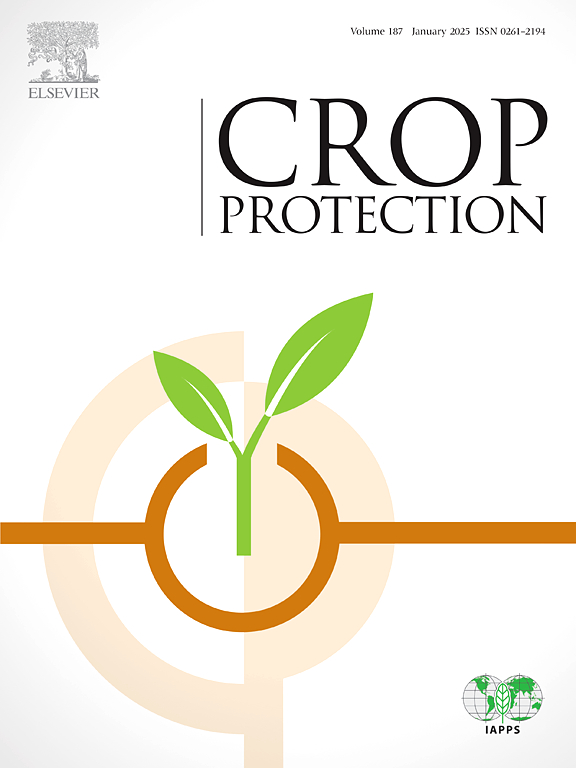Inheritance and fitness costs of Cry1Ab and Cry1Ac resistance in Brazilian populations of Diatraea saccharalis (Lepidoptera: Crambidae)
IF 2.5
2区 农林科学
Q1 AGRONOMY
引用次数: 0
Abstract
The sugarcane borer, Diatraea saccharalis (F.), is the main insect pest on sugarcane in the Americas. Recently, transgenic Bacillus thuringiensis (Bt) sugarcane is planted in Brazil to control D. saccharalis. Resistance development is the greatest challenge for the sustainability of Bt crop biotechnology. Inheritance and fitness costs of resistance are essential information needed in developing effective insecticide resistance management (IRM) programs. In this study, multiple crossings were performed to characterize the inheritance and fitness costs of Cry1Ab and Cry1Ac resistance in two Brazilian populations (Cry1Ab_RR and Cry1Ac_RR) of D. saccharalis. Diet-incorporated and plant tissue bioassays showed that both the Cry1Ab and Cry1Ac resistance in the insect is inherited as a single, autosomal, and genetically incompletely recessive gene. Complementation tests showed that the Cry1Ab and Cry1Ac resistance in the two populations shared the same resistance gene. Leaf tissue bioassays suggested that the Cry1Ac sugarcane variety (CTC9001BT) tested in the study most likely meets the ‘high dose’ requirement for D. saccharalis as defined in the ‘high dose/refuge’ IRM strategy for Bt crops, while additional studies are needed to document the ‘high dose’ qualification for the tested Cry1Ab sugarcane variety (CTC20BT). Effective dominance levels of resistance decreased as Bt concentrations increased, suggesting that elevating Bt protein expressions in plants could be an effective strategy to make a ‘non-high dose’ plant become a ‘high dose’ plant. The Bt resistance in Cry1Ab_RR and Cry1Ac_RR was not associated with fitness costs on both non-Bt sugarcane and non-Bt corn/meridic diet. Knowledge generated from this study is useful in resistance risk assessment, monitoring, and development of IRM programs for the sustainable use of Bt sugarcane technology for pest management.
巴西糖翅蝗种群Cry1Ab和Cry1Ac抗性的遗传和适应代价(鳞翅目:革蛾科)
甘蔗螟虫(Diatraea saccharalis)是美洲甘蔗的主要害虫。最近,在巴西种植了转基因苏云金芽孢杆菌(Bt)甘蔗来防治糖瘟。抗性发展是Bt作物生物技术可持续性面临的最大挑战。抗性的遗传和适应成本是制定有效的杀虫剂抗性管理(IRM)计划所需的基本信息。本研究采用多重杂交方法,对两个巴西种群(Cry1Ab_RR和Cry1Ac_RR)的Cry1Ab和Cry1Ac抗性进行遗传和适应度分析。饮食结合和植物组织生物测定表明,该昆虫的Cry1Ab和Cry1Ac抗性均为单基因、常染色体和不完全隐性遗传基因。互补试验表明,两个群体的Cry1Ab和Cry1Ac抗性基因具有相同的抗性基因。叶片组织生物测定表明,该研究中测试的Cry1Ac甘蔗品种(CTC9001BT)最有可能满足Bt作物“高剂量/避难所”IRM策略中定义的“高剂量”要求,而需要进一步的研究来证明所测试的Cry1Ab甘蔗品种(CTC20BT)的“高剂量”资格。随着Bt浓度的增加,抗性的有效优势水平降低,这表明提高植物中Bt蛋白的表达可能是使“非高剂量”植物成为“高剂量”植物的有效策略。Cry1Ab_RR和Cry1Ac_RR的抗Bt性与非Bt甘蔗和非Bt玉米/子午线饲粮的适应度成本无关。从本研究中获得的知识有助于抗性风险评估、监测和IRM计划的制定,以便可持续地利用Bt甘蔗技术进行病虫害管理。
本文章由计算机程序翻译,如有差异,请以英文原文为准。
求助全文
约1分钟内获得全文
求助全文
来源期刊

Crop Protection
农林科学-农艺学
CiteScore
6.10
自引率
3.60%
发文量
200
审稿时长
29 days
期刊介绍:
The Editors of Crop Protection especially welcome papers describing an interdisciplinary approach showing how different control strategies can be integrated into practical pest management programs, covering high and low input agricultural systems worldwide. Crop Protection particularly emphasizes the practical aspects of control in the field and for protected crops, and includes work which may lead in the near future to more effective control. The journal does not duplicate the many existing excellent biological science journals, which deal mainly with the more fundamental aspects of plant pathology, applied zoology and weed science. Crop Protection covers all practical aspects of pest, disease and weed control, including the following topics:
-Abiotic damage-
Agronomic control methods-
Assessment of pest and disease damage-
Molecular methods for the detection and assessment of pests and diseases-
Biological control-
Biorational pesticides-
Control of animal pests of world crops-
Control of diseases of crop plants caused by microorganisms-
Control of weeds and integrated management-
Economic considerations-
Effects of plant growth regulators-
Environmental benefits of reduced pesticide use-
Environmental effects of pesticides-
Epidemiology of pests and diseases in relation to control-
GM Crops, and genetic engineering applications-
Importance and control of postharvest crop losses-
Integrated control-
Interrelationships and compatibility among different control strategies-
Invasive species as they relate to implications for crop protection-
Pesticide application methods-
Pest management-
Phytobiomes for pest and disease control-
Resistance management-
Sampling and monitoring schemes for diseases, nematodes, pests and weeds.
 求助内容:
求助内容: 应助结果提醒方式:
应助结果提醒方式:


